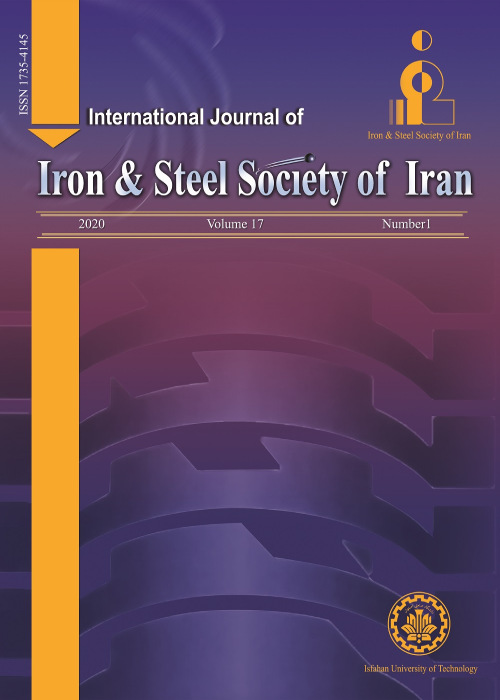فهرست مطالب
International Journal of iron and steel society of Iran
Volume:2 Issue: 2, Summer and Autumn 2005
- تاریخ انتشار: 1384/10/15
- تعداد عناوین: 6
-
-
Page 1The influence of aluminium on the microstructure of austempered ductile cast iron (ADI) has been studied. The presence of well distributed graphite in the matrix, and a relatively high volume fraction of retained austenite are responsible for the good mechanical properties of the Aluminium alloyed austempered ductile irons including excellent wear resistance, higher resistance to thermal shock, better graphitising tendency and higher resistance to oxidation at high temperatures. A number of specimens of different composition have been made by green sand-casting and gravity die-casting. The transformation to a bainitic microstructure during austempering under different conditions was then examined for the most successful experimental casts. Austenitising temperature of 920C, and austempering temperatures of 350C at different holding times have been used. Microstructures have been examined by scanning electron microscopy (SEM) and transmission electron microscopy (TEM). Furthermore, it was found that isothermal transformation at 350C for different soaking times gave a typical bainitic microstructure. Extension of isothermal transformation time leads to precipitation of carbides which also depends on the Al concentration.
-
Page 9The unique properties of air-cooled bainitic steels have been described. A series of Mn containing air-cooled bainitic steels invented by authors is presented in this paper: including low carbon granular bainitic steels, low carbon grain-boundary allotriomorphic ferrite/granular bainite duplex steels, medium and medium high carbon bainite/martensite duplex steel, and low carbon carbide free bainite/martensite duplex steels. The development of ultra-low carbon bainitic steels in China is also introduced.
-
Page 19Despite having some useful properties, stainless steels suffer from lack of suitable surface hardness. In this research electroless Ni-B-Tl coating was used with the aim to increase their surface hardness. The effects of Nickel chloride, Sodium borohydride, Thallium nitrate and Ethylendiamin on the chemical composition of coating were studied. To achieve an increase in hardness, the effects of heat treatment on the hardness of the deposited layer at various temperatures, were also studied. The results showed that the deposition rate and surface hardness of the deposited layer were affected by the variation in concentration of bath components. The micro structure of the electroless Ni-B-Tl coating consists of nickel and super saturated solid solutions. It was also found that the hardness of the coating was increased due to the formation of Ni2B and Ni3B phases during heat treatment.
-
Page 24The objectives in the cold rolling process include improved sheet surface quality, enhanced steel mechanical strength, and better solidification operations. Given the increasing demand for higher steel surface quality, more rapid production, and thinner steel plates, more attention has been directed toward the parameter of temperature in cold rolling as a means of achieving the above objectives. Due to the friction between work rolls and steel sheet caused during the cold rolling process and because of temperature changes of the work piece during plastic work, a non-uniform temperature distribution results along the work roll axial direction which ultimately leads to improper and undesirable expansion of the work roll along its axis. This, in turn, causes an uneven work roll slide on sheet surface; hence, the uneven and wavy steel surface. In this study, we used headers with a variety of nozzles for cooling the work rolls in order to achieve uniform temperature distribution and thermal expansion of the work roll. In this method, the cooling system is applied to the work roll in such a way that the work roll gains the desired efficiency in terms of both optimized energy consumption and work roll thermal expansion.
-
Page 30Dual phase steels with different martensite volume fraction and morphology were tensile tested at a temperature range of 25 to 5500C. Stress-strain curves of all steels showed serration flow at temperatures of 250 and 3500C, and smooth flow at the other temperatures. Both yield and ultimate tensile strengths increased with increasing testing temperature up to about 4500C and then decreased at higher temperatures. At a given temperature, yield stress, tensile strength, and work hardening increased with increasing volume fraction of martensite. Similar behavior was observed by changing martensite morphology from network to fibrous martensite. The change in mechanical properties was related to the effects of dynamic strain aging, high temperature softening, and martensite tempering.
-
Page 36In the present work the recrystallization behavior of deep drawing grade Al-killed low carbon steel sheets produced by Mobarakeh Steel Plant (MSP) has been studied. Salt bath isothermal annealing has been applied to cold rolled samples and the resulted microstrucrures have been compared with the microstructure obtained from the box annealing process in MSP. It is found that at 635 and 700ºC the isothermal annealing produces equiaxed grains, while box annealing process presents an elongated grain structure. The recrystallization fractions have been measured using the point counting method. The linear intercept method has been employed to measure the grain size. It is revealed that at 550ºC, in salt bath annealing, recrystallization is stopped after 50% recrystallization with elongated new grains. Constant grain sizes upon holding after recrystallization at 635 and 700ºC during isothermal annealing show that the grain growth is stopped. Further holding at 700ºC results an abnormal grain growth in the recrystalized microstructure. The hardness variations during annealing, with a decrease at the beginning of annealing followed by an increase trend at all temperatures, show a good consistency with microstructural observations. Investigation of the results leads to the conclusion that a precipitation process occurs during annealing which greatly affects both restoration processes and resulted microstructure as well as the properties. The effect of the precipitation process depends on the time of its occurrence with respect to each restoration process. A Relatively high value of 315 KJ/mole for recrystallization activation energy has been related to the simultaneous occurrence of recrystallization and precipitation processes.


